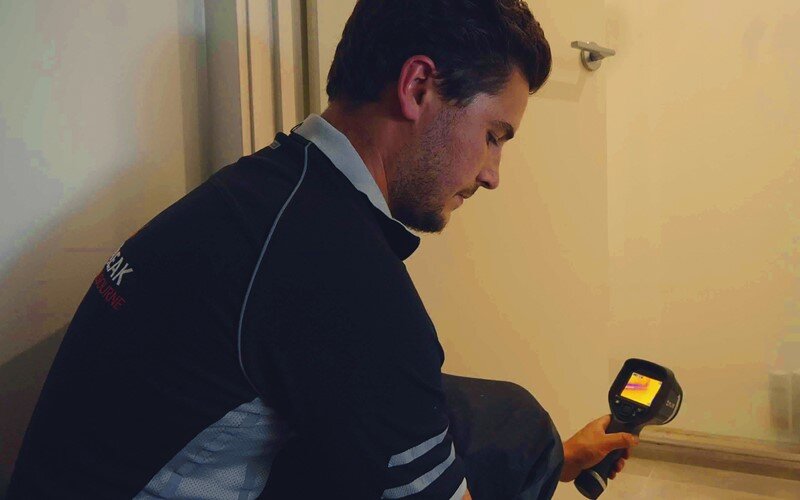Expose Concealed Water Line Leaks: 6 Tested Ways for Spotting
Expose Concealed Water Line Leaks: 6 Tested Ways for Spotting
Blog Article
Have you been trying to find facts concerning Locating water leaks?

The minute you find a leak, calling your plumber for repair services is the best option. Some tiny water leaks may not be noticeable. Here are some hacks that assist if you can not identify it with your naked eyes.
Early detection of leaking water lines can alleviate a potential disaster. Besides conserving you cash, it will certainly lessen the irritation as well as stress.
Check Water Usage
If you spot sudden changes, despite your consumption being the same, it implies that you have leaks in your plumbing system. A sudden spike in your bill indicates a fast-moving leakage.
A steady rise every month, even with the exact same practices, reveals you have a sluggish leakage that's additionally slowly escalating. Call a plumber to thoroughly examine your residential or commercial property, particularly if you feel a cozy location on your floor with piping underneath.
Analyze the situation and inspect
Home owners must make it a practice to check under the sink counters and also even inside closets for any kind of bad odor or mold and mildew growth. These two warnings indicate a leakage so timely attention is called for. Doing routine examinations, also bi-annually, can save you from a major issue.
Analyze the Water Meter
Every residence has a water meter. Inspecting it is a surefire manner in which helps you uncover leaks. For starters, shut off all the water sources. Make sure no one will certainly flush, make use of the faucet, shower, run the cleaning machine or dish washer. From there, go to the meter and also watch if it will transform. Because no person is using it, there need to be no movements. That indicates a fast-moving leakage if it moves. Similarly, if you detect no changes, wait a hr or 2 and examine back again. This indicates you might have a slow leakage that could even be below ground.
Asses Outside Lines
Do not forget to inspect your outside water lines also. Should water seep out of the connection, you have a loosened rubber gasket. One little leakage can waste tons of water and surge your water expense.
Do a Food Coloring Examination
30% comes from bathrooms when it comes to water intake. Test to see if they are running properly. Drop specks of food shade in the container as well as wait 10 minutes. If the color somehow infiltrates your bowl throughout that time without flushing, there's a leakage between the tank and also dish.
Examine for discolorations and also deteriorating as most devices as well as pipelines have a life expectancy. If you presume leaking water lines in your plumbing system, do not wait for it to escalate.
The minute you locate a leak, calling your plumber for fixings is the best option. Some tiny water leaks might not be noticeable. Examining it is a surefire method that aids you discover leakages. One small leakage can lose heaps of water as well as spike your water bill.
If you suspect dripping water lines in your plumbing system, do not wait for it to rise.
How to Know If Your Home Has a Hidden Leak
Water Meter Reveals Inexplicable Water Usage
If you’d like to test whether or not there’s a leak somewhere in your home, you can do this using your water meter. Here is how to conduct the test:
Don’t use any water in your home for at least 30 minutes; this also means not turning on faucets or water-using appliances.
Go outside, and check your water meter for activity.
If your water meter shows that there was activity, even though no one was using any water, this proves that there is a leak in your home.Visible Mold or Mildew Growth
Leaks behind walls create moist, dark environments that allow mold and mildew to grow and thrive. Eventually, you might see mold growth forming on the wall closest to a hidden leak.
If mold is growing in an area that receives a high amount of moisture, such as a bathroom, it may simply be an indication that better ventilation is needed. However, if you see mold growth on a wall or the ceiling in an area where you would not expect, you probably have a hidden leak.
Musty, Mildew Odor
Sometimes you might not be able to see the mold or mildew that is growing as a result of a leak. However, the smell can give the problem away just as easily. If you catch a whiff of something musty, there’s a good chance that old water is collecting somewhere in your home that you can’t see.
Stained/Warped Walls, Ceilings, or Floors
When your home soaks up water, a variety of red flags can become visible, including ceiling stains, bubbling drywall, warped walls, and sagging floors. While these issues can be caused by excess humidity, they can also be signs that a pipe or plumbing connection has started leaking behind your walls.
Inexplicably High Water Bill
After a while, you get a general sense for what your water bill should be. If you own a pool or sprinkler system, your bill will tend to be higher during summer. However, if you receive a water bill that seems especially high, and you can’t figure out what caused it, then you may have a hidden leak somewhere that’s increasing your bill.
https://www.plumbingjoint.com/blog/2019/july/how-to-know-if-your-home-has-a-hidden-leak/

We hope you liked our article about Leaking water lines. Thank you so much for spending some time to browse our posting. Are you aware of someone else who is curious about Detecting hidden plumbing leaks? Feel free to promote it. I enjoy reading our article about Leaking water lines.
Quick, reliable, call! Report this page